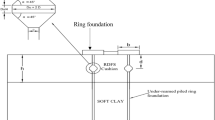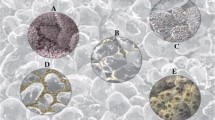Abstract
Expansive clay minerals can be a serious threat to underground rock structure because of their swelling behavior when absorbing water. Roof and wall collapse as well as large deformation were observed in Xiaotun Coal Mine, Guizhou Province, China. This paper studies the characteristics of expansive clays in order to understand the mechanism of the mudstone tunnel failures in the mine. The physical and mechanical properties of the tunnel surrounding rock samples, including mudstone, silty mudstone, argillaceous siltstone and fine sandstone were determined. X-ray diffraction analysis was conducted to determine the mineralogical composition while the scanning electron microscope was used to examine the internal structure of the different samples. The results indicate that the illite–smectite and the montmorillonite are the main minerals composing the rock samples. A series of micro-cracks and pores occur in the samples which suggest a good hydraulic conductivity. The results indicate that the mudstone has poorer mechanical properties in comparison to the fine sandstone. Also, the Flac3D numerical simulations were conducted and it was shown that the large deformations were consistent with the field observation due to weak mechanical properties of the surrounding rock under seepage action especially with the increase of water head and porosity. It is concluded that internal structure and mechanical strength of the mudstone is weakened by the illite–smectite and the montmorillonite mineral content as well as the combined action of underground water causing physical disintegration.








Similar content being viewed by others
References
Bell FG (1998) The geotechnical properties and behaviour of a pro-glacial lake clay, and its cementitious stabilization. Geotech Geol Eng 16(3):167–199
Bonini M, Debernardi D, Barla M, Barla G (2007) The mechanical behaviour of clay shales and implications on the design of tunnels. Rock Mech Rock Eng 42(2):361–388
Butscher C, Huggenberger P, Zechner E (2011) Impact of tunneling on regional groundwater flow and implications for swelling of clay–sulfate rocks. Eng Geol 117(3–4):198–206
Dominijanni A, Manassero M (2012) Modelling the swelling and osmotic properties of clay soils. Part I: the phenomenological approach. Int J Eng Sci 51:32–50
Farhadian H, Aalianvari A, Katibeh H (2012) Optimization of analytical equations of groundwater seepage into tunnels: a case study of Amirkabir tunnel. J Geol Soc India 80(1):96–100
Fityus S, Buzzi O (2009) The place of expansive clays in the framework of unsaturated soil mechanics. Appl Clay Sci 43(2):150–155
Grammatikopoulou A, Schroeder FC, Gasparre A, Kovacevic N, Germano V (2013) The influence of stiffness anisotropy on the behaviour of a stiff natural clay. Geotech Geol Eng 32(6):1377–1387
Itasca Consulting Group (2003) FLAC3D manual. Itasca Consulting Group Inc., Minnesota
Jiang CX, Shi HP, Li Y, Yu HM (2015) Numerical simulation of groundwater under complex karst conditions and the prediction of roadway gushing in a coal mine: a case study in the Guang’an Longtan Reservoir in Sichuan Province, China: Acta. Geochimica 35(1):72–84
Jiao YY, Song L, Wang XZ, Adoko AC (2013) Improvement of the U-shaped steel sets for supporting the roadways in loose thick coal seam. Int J Rock Mech Min Sci 60:19–25
Lei X, Wong H, Fabbri A, Limam A, Cheng YM (2014) A thermo-chemo-electro-mechanical framework of unsaturated expansive clays. Comput Geotech 62:175–192
Li Z, Wang X (2010) Study on deformation failure and control strategy for deep large span soft rock roadway. In: Zhu R, Zhang Y, Liu B, Liu C (eds) Information computing and applications: international conference, ICICA 2010, Tangshan, China, October 15–18, 2010. Proceedings, part II. Springer, Berlin, Heidelberg, p. 297–304
Li XB, Zhang W, Li DY, Wang QS (2008) Influence of underground water seepage flow on surrounding rock deformation of multi-arch tunnel. J Central S Univ Technol 15(1):69–74
Lin B, Cerato AB (2011) Prediction of expansive soil swelling based on four micro-scale properties. Bull Eng Geol Environ 71(1):71–78
Lippmann F (1975) Corrensite, a swelling clay mineral, and its influence on floor heave in tunnels in the Keuper formation. Bull Int Assoc Eng Geol 14(1):65–68
Liu S, Lu Y, Weng L, Bai F (2015) Field study of treatment for expansive soil/rock channel slope with soilbags. Geotext Geomembr 43(4):283–292
Ma D, Miao XX, Bai HB, Huang JH, Pu H, Wu Y, Zhang GM, Li JW (2016) Effect of mining on shear sidewall groundwater inrush hazard caused by seepage instability of the penetrated karst collapse pillar. Nat Hazards 82(1):73–93
Monroy R, Zdravkovic L, Ridley AM (2015) Mechanical behaviour of unsaturated expansive clay under K0 conditions. Eng Geol 197:112–131
Muthukumar M, Phanikumar BR (2015) Shrinkage behaviour of GPA-reinforced expansive clay beds subjected to swell-shrink cycles. Geotech Geol Eng 33(3):475–485
Papagiannakis AT, Bin-Shafique S, Lytton RL (2014) Retaining structures in expansive clays. Geotech Geol Eng 32(6):1405–1414
Pérez-Romero J, Oteo CS, de la Fuente P (2007) Design and optimisation of the lining of a tunnel in the presence of expansive clay levels. Tunn Undergr Sp Technol 22(1):10–22
Seco A, Ramírez F, Miqueleiz L, García B (2011) Stabilization of expansive soils for use in construction. Appl Clay Sci 51(3):348–352
Shaobin D, Minghai S, Jun H (2005) Engineering properties of expansive soil. J Wuhan Univ Technol Mater Sci Ed 20(2):109–110
The Professional Standards Compilation Group of People’s Republic of China (1995) GB 50218-94 standard for engineering classification of rock masses. China Railway Press, Beijing
Acknowledgments
This study is supported by the National Basic Research Program of China (973 Program) (2014CB046904), the China National Natural Science Foundation (51479191, 41472288), and the Key Research Program of the Chinese Academy of Sciences (KZZD-EW-05-03). We are grateful to the anonymous reviewers and the journal editors.
Author information
Authors and Affiliations
Corresponding author
Rights and permissions
About this article
Cite this article
Zhang, H., Adoko, A.C., Meng, Z. et al. Mechanism of the Mudstone Tunnel Failures Induced by Expansive Clay Minerals. Geotech Geol Eng 35, 263–275 (2017). https://doi.org/10.1007/s10706-016-0102-y
Received:
Accepted:
Published:
Issue Date:
DOI: https://doi.org/10.1007/s10706-016-0102-y




